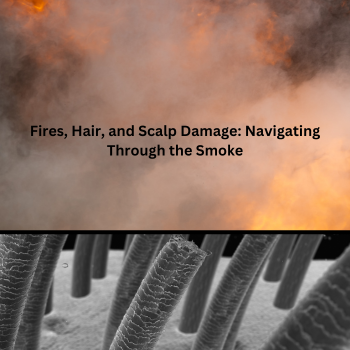Hair is not complicated in terms of its structure and what it is composed of, but it plays an important role in social functioning. The way we style, cut, color, and maintain our hair all contribute to the way we look. Whether it’s having a signature look or hair you rolled out of bed with it is an integral part of a showcasing personality and identity. But what really is this thing that we spend so much time and effort on? What is hair?
The Hair Follicle
 The hair follicle, made of a strong protein known as keratin, is the innermost part of the hair after the hair root. Hair follicles are the living part of the hair. They are located beneath the skin on our scalp otherwise known as the epidermis. It serves the purpose of anchoring each individual hair into the skin. Hair follicles are not visible unless you were to pluck a strand of hair out of the scalp. The hair follicle is important because it is the point from which hair begins to grow.
The hair follicle, made of a strong protein known as keratin, is the innermost part of the hair after the hair root. Hair follicles are the living part of the hair. They are located beneath the skin on our scalp otherwise known as the epidermis. It serves the purpose of anchoring each individual hair into the skin. Hair follicles are not visible unless you were to pluck a strand of hair out of the scalp. The hair follicle is important because it is the point from which hair begins to grow.
Breaking Down The Shaft of the Hair Follicle
The main function of the hair follicle is to produce a fiber known as the hair shaft. It is the nongrowing/nonliving portion of a hair that protrudes from the skin. There are three main layers of the hair shaft that are not visible to the naked eye. Inside the hair shaft is the medulla, the cortex, and the cuticle.
Medulla
The medulla, or the proper name, the medullary canal, is the deepest and innermost part of the hair shaft. This part of the hair shaft is not highly pigmented, so it is nearly invisible. This layer is also incredibly fragile and serves as the pith or marrow of the hair. Scientists are still uncertain about the exact role of the medulla, but it has been speculated that it is primarily an extension that is more common in those with gray or white hair.
Cortex
The cortex is the middle layer, and it makes up the majority of the hair fibers. The cortex is what provides the hair with color and texture. The cortex contains a pigment known as melanin, which is also present in the skin. This layer determines the strength or weakness of one’s hair.
Cuticle
The cuticle, the third and outermost layer, meaning that it is the closest to the surface, is nearly invisible, its main purpose is to act as a protective lining for the cortex.
The Hair Bulb
 As we descend towards the lowermost part of the hair follicle, we approach what is known as the hair bulb. The hair bulb is something that forms the base of the hair follicle. Inside the hair bulb, there are living cells that divide and grow to build the hair shaft. Blood vessels give nourishment to the cells in the hair bulb, and deliver hormones that affect the amount of hair growth, and where it grows, at different times of a person’s life. The hair bulb encapsulates the hair matrix, the hair papilla, the inner root sheath, and the outer root sheath.
As we descend towards the lowermost part of the hair follicle, we approach what is known as the hair bulb. The hair bulb is something that forms the base of the hair follicle. Inside the hair bulb, there are living cells that divide and grow to build the hair shaft. Blood vessels give nourishment to the cells in the hair bulb, and deliver hormones that affect the amount of hair growth, and where it grows, at different times of a person’s life. The hair bulb encapsulates the hair matrix, the hair papilla, the inner root sheath, and the outer root sheath.
Hair Matrix
The hair matrix is the outer layer involved in the body’s hair production. It produces the actual hair shaft as well as the inner and outer root sheaths of hair.
Inner Root Sheath
The inner root sheath of the hair follicle is located between the hair shaft and the outer root sheath. It is made of three layers:
- Henle’s layer is the outermost layer of the inner root sheath, it consists of a single row of cubical cells. It is named after German physician, pathologist and anatomist Friedrich Gustav Jakob Henle.
- Huxley’s layer is the layer of the inner stratum of a hair follicle composed of one or two layers of horny flattened epithelial cells with nuclei and situated between Henle’s layer and the cuticle next to the hair. The layer is named after the English biologist Thomas Henry Huxley.
- The Cuticle, the previously mentioned outermost layer.
Outer Root Sheath
To better understand the outer root sheath, let’s first take a look at the stratum mucosum and the base membrane.
- The Stratum Mucosum, or the mucous layer, is made of multiple layers of cells; those of the deepest layer are column-like or cylindrical in shape and placed perpendicularly on the surface of the base membrane.
- The Base Membrane is a base for the sensory cells.
That being said, the outer root sheath is very similar to the stratum mucosum (Stratum germinativum and Stratum Spinosum) of the epidermis. This layer resembles the mucous layer in the rounded form and soft makings of its cells. At the bottom of the hair follicle, these cells become continuous with those of the root of the hair.
Hair Papilla
The papilla is a large composition at the bottom of the hair follicle. The papilla is made up mainly of connective tissue and a capillary loop. Cell division in the papilla is either rare or non-existent. Around the papilla is the hair matrix.
- Capillary Loops are any of the small blood vessels that carry blood in the papillae of the skin.
The Layers of the Dermis (Skin) and the Surrounding Area
Now that we have covered what makes up a hair follicle, let’s dive into the layers of the dermis and the surrounding area.
Epidermis
The epidermis is the thin, arranged outer skin layer extending downward to the sub-epidermal base of the membrane. Keratinocytes are the principal cells of the epidermis which produce keratin. The cells replicate in the basal cell layer and migrate up toward the surface of the skin. On the surface, they are shed off or lost by abrasion. The epidermis is constantly regenerating itself which provides a tough keratinized barrier.
Dermis
Just beneath the epidermis, we have the dermis which is the middle layer of skin. It contains tough connective tissue, nerve endings, sweat glands and oil (sebaceous) glands, arrector pili muscle, and hair follicles.
- Nerve Endings sense pain, touch, pressure, and temperature.
- Sweat Glands – sweat (mostly water containing some salt) produced by glands in the dermis. Its main function is to control body temperature.
- Sebaceous Glands, not to be confused with sweat glands, are small oil-producing glands in the dermis. Sebaceous glands are usually attached to hair follicles and release sebum, a fatty-like substance, into the follicular duct and then to the skin’s surface. The glands are distributed over the entire body with the exception of the palms of the hands and the soles of the feet; they are most abundant on the scalp and face.
- Arrector Pili Muscle, is one of the small, fan-like shaped, smooth muscles associated with the base of each hair that develops when the body surface is chilled and the hairs erect, compress an oil gland above each muscle, and produce the appearance of, what we know as, goosebumps.
Hypodermis (Subcutaneous Tissue)
The subcutaneous tissue or the hypodermis, is the deepest layer of skin. It attaches the skin to deeper tissues and organs. The subcutaneous hypodermis layer is a specialized layer of connective tissue containing adipocytes (a cell specialized for fat storage). It consists mainly of areolar connective tissue (loose connective tissue) and adipose tissue (fat storage). It is the area used for subcutaneous injections and where white blood cells attack pathogens that have penetrated the skin. Subcutaneous adipose tissue also absorbs the forces made by any impact to the skin, which protects deeper structures, and serves as a storage area for fat. It also serves to insulate the body by conserving body heat and limiting the penetration of outside heat into the body. Blood vessels and nerves within the subcutaneous tissue give off branches that nourish the dermis.
- Blood vessels, in the hypodermis, are bigger and are connected to the rest of the body. The three main types of blood vessels are arteries, veins, and capillaries.
- Arteries are blood vessels that transfer blood away from the heart and disperse it to the rest of the body. They are tube-like and branch into arterioles to reach the organs and tissues. The heart’s pumping contractions propel the blood to flow through the arteries.
- Veins are blood vessels that carry the deoxygenated blood back to the heart from the body tissues in the circulatory system.
- Capillaries are the smallest and most numerous of the blood vessels. They act as the connection between the vessels that carry blood away from the heart (arteries) and the vessels that return blood to the heart (veins). The primary function of capillaries is the exchange of materials between the blood and tissue cells.
What causes hair growth and hair loss?
 So now that you are an expert on the anatomy of the hair follicle and the environment it produced in, let’s take a look at what causes hair growth and what the cause is for the lack of hair growth.
So now that you are an expert on the anatomy of the hair follicle and the environment it produced in, let’s take a look at what causes hair growth and what the cause is for the lack of hair growth.
Although hair isn’t intrinsically complicated by design, the process of hair growth and the function of what hair does is far more complicated than it seems. It helps in transmitting sensory information, it serves as a barrier to foreign particles, and it is the only bodily structure that can completely reproduce itself without any scarring. There is hair on practically every surface of the human body.
Biological Hair Growth
By week 22 of its life, a developing fetus will have formed all of its hair follicles. At this time, there are roughly 5 million hair follicles on the body. Approximately one million of those are on the head and 100,000 are on the scalp. This is the largest number of hair follicles a person will ever have due to the fact that hair follicles do not continue to grow throughout life. As we age, the amount and thickness of hair follicles decreases.

The Hair Growth Cycle
The hair on the scalp grows about a half a millimeter per day which adds up to roughly six inches of hair growth per year. Hair growth and loss is random. It is not seasonal or cyclical. Hair is always in a variety of different stages of growth and may shed at any given time. There are three stages in which hair grows: anagen, catagen, and telogen.
- Anagen, the first phase, is known as the active phase of hair growth. Hair, for the most part, will typically grow at a constant speed and will spend between three and four years in this stage. A new hair forms and pushes the club hair up and out of the follicle. At this point in the process of hair growth, hair grows approximately one centimeter per month. Some people have discovered that they have a difficult time growing out their hair beyond a certain point due to having a short anagen phase. The anagen phase for eyelashes, eyebrows, and leg and arm hair is also a very short period of roughly a month to a month and a half—about 30 to 45 days—which would explain the reason those hairs are far shorter than hair on the scalp.
- Catagen, the second stage, is a transitional phase that lasts for two to three weeks (3% of all hairs are in this stage at any point in time). At this point, hair growth slows down and the outer root sheath will shrink and attach itself to the root of the hair, this forms what is called a club hair.
- Telogen, is the third and final stage of biological hair growth. It is the resting phase, which lasts for approximately 90 days and accounts for 10% to 15% of all hair. During this stage, the hair follicle is at rest and the club hair is completely established. Removing a strand of hair during this time will reveal a solid, dry, white material at the root. Typically, the body will shed about 50 to 100 hair from the scalp every day.
The Science Behind Hair Loss
Hair loss, or alopecia by its proper name, has multiple degrees of severity. It may affect just your scalp or it can affect your entire body. It may be temporary or permanent. It can be the result of genetics, hormonal changes, medical conditions or just a normal part of aging. Anyone can lose hair on their head, at any point in time, Hair loss, of course, doesn’t recognize gender boundaries and affects both the sexes differently. Men may develop a bald spot or a receding hairline, or go completely bald while women may experience a gradual thinning of hair. That being said, cases of hair loss are typically most often seen in men.
 Baldness typically refers to an excessive amount of hair loss from the scalp. The most common cause for baldness and hair loss is due to genetics. Additionally, androgens, which are hormones that primarily rinduce and maintain male secondary sex characteristics. Testosterone, the principal androgen, is produced in men’s testes and the adrenal glands, in much smaller quantities compared to the amounts produced in the ovaries and adrenal glands of women.
Baldness typically refers to an excessive amount of hair loss from the scalp. The most common cause for baldness and hair loss is due to genetics. Additionally, androgens, which are hormones that primarily rinduce and maintain male secondary sex characteristics. Testosterone, the principal androgen, is produced in men’s testes and the adrenal glands, in much smaller quantities compared to the amounts produced in the ovaries and adrenal glands of women.
Testosterone plays a key role in baldness and hair loss, but it only affects hair follicle cells that are genetically liable to the condition. In the case where men are more susceptible to baldness or hair loss, testosterone comes into contact with an enzyme found in the hair follicles. When this happens, the testosterone is converted to dihydrotestosterone, which is a more potent androgen. Dihydrotestosterone has the ability to bind to receptors in the hair follicles that can trigger a change in the genetic activity of the cells, which initiates the gradual process of hair loss.
Although the presence of androgens is critical for the genetic predisposition to be conveyed, age is equally influential. That being said, The biological workings of this are not fully understood at this time, but it is known that the susceptibility of hair loss and baldness does increase with age. Another factor to consider is that different ethnic groups also have varying susceptible levels of pattern baldness: Statistics show that roughly 30 percent of caucasian men in their 30s are affected by pattern baldness, as are 40 percent in their 40s, and so on to the point that 80 percent of caucaisian men are affected by the time they are 80 or older. Meanwhile statistics have shown a much lower percentage of hair loss and pattern baldness in other ethnicities.
Other factors including physical stress, emotional stress, and chemotherapy are all contributing factors that may lead to hair loss in both men and women alike.
In regards to female hair loss, some research has also shown that additional hormonal factors can come into play. This is supported by the fact that significant hormonal changes such as menopause can cause female hair loss.
Some people prefer to combat any hair loss or baldness while others may cover it up with certain hairstyles, makeup, hats or scarves. And still others may choose one of the various treatments available to them to aid in preventing any further hair loss or the inability to restore hair growth.
It is always strongly advised to consult with your doctor before pursuing hair loss treatment and/or treatment options.




